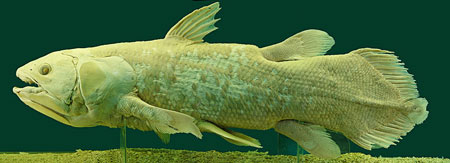
Subscribe & Follow
#AfricaMonth
Jobs
- Brand and Marketing Manager Johannesburg
- Global Senior Talent Delivery Researcher Cape town
- CRM and Lifecycle Manager Cape Town
- Paid Social Campaign Manager (Junior–Mid Level) Cape Town
- Digital Content Creator Cape Town
- Sales Representative - Digital Print Johannesburg
- Junior Account Executive Cape Town
- Lecturer: Language Conversational Sign Language Cape Town
- Digital Marketing and Content Creator Specialist Johannesburg
- Content Marketing Manager Cape Town
Researchers decode genome of African coelacanth
A sea-cave dwelling, five-foot long fish with limb-like fins, the coelacanth was once thought to be extinct. A living coelacanth was discovered off the African coast in 1938, and since then, questions about these ancient-looking fish - popularly known as "living fossils" - have loomed large. Coelacanths today closely resemble the fossilised skeletons of their more than 300-million-year-old ancestors. Its genome confirms what many researchers had long suspected: genes in coelacanths are evolving more slowly than in other organisms.
In a paper on the coelacanth genome, which appears in Nature this week, researchers hypothesise that this slow rate of change may be because coelacanths simply have not needed to change: they live primarily off of the Eastern African coast (a second coelacanth species lives off the coast of Indonesia), at ocean depths where relatively little has changed over the millennia.

"Living fossils"
Because of their resemblance to fossils dating back millions of years, coelacanths today are often referred to as "living fossils" - a term coined by Charles Darwin. But the coelacanth is not a relic of the past brought back to life: it is a species that has survived, reproduced, but changed very little in appearance for millions of years. "It's not a living fossil; it's a living organism," said Jessica Alföldi, from the Broad Institute and co-first author. "It doesn't live in a time bubble; it lives in our world, which is why it's so fascinating to find out that its genes are evolving more slowly than ours."
In addition to sequencing the full genome - nearly three billion "letters" of DNA - from the coelacanth, the researchers also looked at RNA content from coelacanth (both the African and Indonesian species) and from the lungfish. This information allowed them to compare genes of lungfish with gene sets from coelacanth and 20 other vertebrate species. Their results suggested that land animals (tetrapods) are more closely related to lungfish than to the coelacanth.
However, the coelacanth is still a critical organism to study in order to understand what is often called the water-to-land transition. Lungfish may be more closely related to land animals, but the lungfish genome is simply too unwieldy for scientists to sequence, assemble, and analyse. The coelacanth's more modest-sized genome (comparable in length to our own) is yielding valuable clues about the genetic changes that may have allowed tetrapods to flourish on land.
Uniquely challenging
Sequencing the full coelacanth genome was uniquely challenging for many reasons: Coelacanths are endangered animals, meaning that samples available for research are almost non-existent. This meant that each sample obtained was precious: researchers would have one shot at sequencing the collected genetic material, according to Alföldi. But the difficulties in obtaining a sample and the challenges of sequencing it also knit the community together.
Researchers from 40 institutions across 12 countries contributed to this work. Many funding agencies around the world provided support, from South Africa these included the South African Institute for Aquatic Biodiversity (SAIAB) African Coelacanth Ecosystem Programme (ACEP) incorporating the South African Environmental Observation Network (SAEON), funded by the South African National Department of Science and Technology, which supported the collection of samples from coelacanths found off Sodwana Bay on the east coast of South Africa, Rhodes University and the National Human Genome Research Institute, which supported the Broad Institute's contributions including genome sequencing.
Dr Angus Paterson, MD of SAIAB and ACEP, said, "Over the past decade, ACEP has made a conscious effort to provide specialised marine platforms including ROVs, submersibles and vessels to support marine research. We are thrilled that SAIAB's support of the project has produced such high quality research and a well-deserved place in coelacanth research history, especially in this 75th year since the discovery of this enigmatic creature."
Related
Rhodes University bids farewell to transformative chancellor Justice Lex Mpati 3 Apr 2025 South Africa’s modern rondavels: family homes may be changing, but traditions remain 3 Jan 2025 Universities must teach students what freedom is – a South African course is trying to do just that 19 Dec 2024 Rhodes University plans water independence from municipality 4 Sep 2024 TikTok SSA Safety Advisory Council an industry-first 23 Aug 2024 Bid to save legendary Lovedale Press 5 Jun 2024








